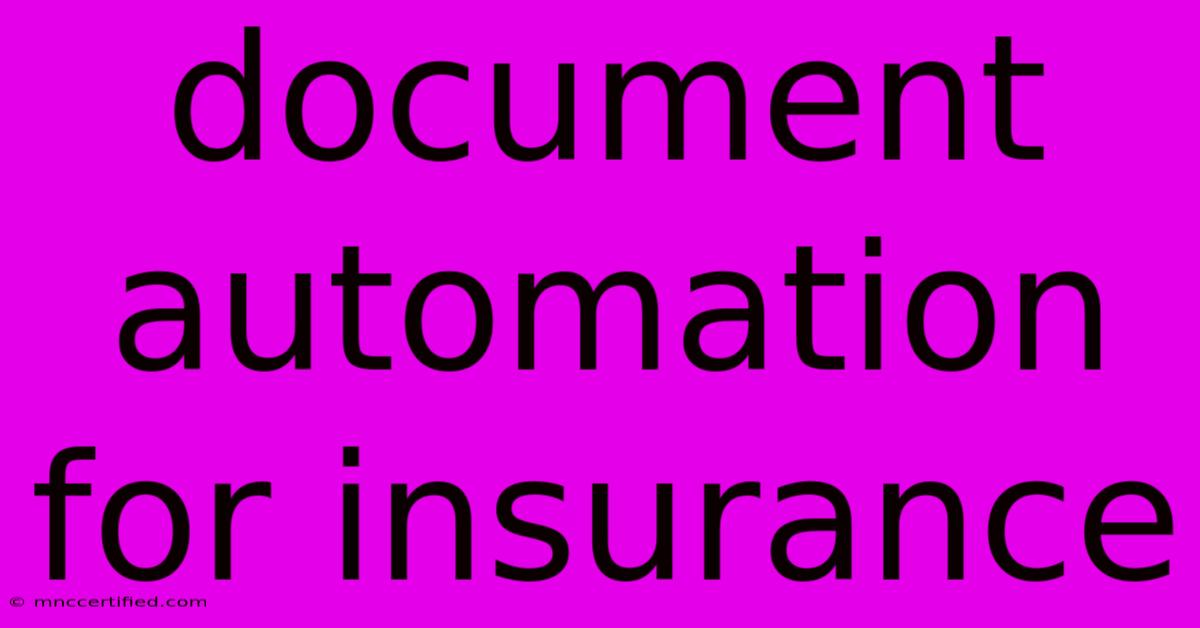Document Automation For Insurance

Table of Contents
Streamlining Success: Document Automation for the Insurance Industry
The insurance industry is a paperwork powerhouse. From policy documents and claims forms to compliance reports and client communications, the sheer volume of documentation can be overwhelming. This is where document automation steps in, offering a powerful solution to boost efficiency, reduce costs, and improve accuracy. This article explores how document automation is revolutionizing insurance operations.
The Challenges of Manual Documentation in Insurance
Before diving into the solutions, let's acknowledge the problems associated with traditional, manual document processes:
- Time-Consuming: Manually creating and processing documents is incredibly time-consuming, diverting valuable resources from other crucial tasks.
- Error-Prone: Human error is inevitable, leading to inaccurate information, delays, and potential legal issues. Incorrect policy details or claim forms can have significant consequences.
- High Costs: The labor involved in manual document handling translates to substantial operational costs.
- Inconsistent Branding: Maintaining a consistent brand image across all documents can be challenging with manual processes.
- Slow Turnaround Times: Delays in processing documents lead to frustrated clients and potential revenue loss.
- Compliance Risks: Non-compliance with regulations can result in hefty fines and reputational damage. Manual processes increase the risk of missing critical information or failing to adhere to legal requirements.
Document Automation: A Game-Changer for Insurance Companies
Document automation software offers a comprehensive solution to these challenges. By automating the creation, processing, and management of documents, insurance companies can:
1. Boost Efficiency and Productivity
- Automated Generation: Templates can be created for various document types, generating accurate, consistent documents in seconds. This frees up employees to focus on higher-value tasks.
- Reduced Manual Input: Data can be automatically populated from various sources, minimizing manual data entry and reducing errors.
- Faster Turnaround Times: Automated workflows expedite the entire document lifecycle, ensuring faster processing and quicker turnaround times for clients.
2. Improve Accuracy and Reduce Errors
- Error Minimization: Automated processes significantly reduce the risk of human error, ensuring accuracy in policy details, claim information, and compliance documentation.
- Data Validation: Document automation tools often include data validation features to ensure consistency and accuracy.
- Version Control: Maintaining different versions of documents becomes easier with automated systems, avoiding confusion and ensuring all stakeholders work with the latest version.
3. Lower Costs and Optimize Resources
- Reduced Labor Costs: Automation reduces the need for manual labor, leading to significant cost savings.
- Improved Resource Allocation: Employees can focus on strategic initiatives rather than tedious administrative tasks.
- Increased Revenue: Faster processing and improved efficiency lead to higher client satisfaction and increased revenue potential.
4. Enhance Client Experience and Satisfaction
- Faster Claim Processing: Automated claim forms and processing significantly reduce claim turnaround times, improving client satisfaction.
- Personalized Communications: Automated systems allow for personalized client communication, strengthening relationships and loyalty.
- Self-Service Portals: Clients can access documents and information anytime, anywhere, fostering greater independence and convenience.
5. Strengthen Compliance and Risk Management
- Automated Compliance Checks: Document automation software can incorporate compliance rules and regulations, ensuring all documents adhere to legal requirements.
- Audit Trails: Automated systems maintain detailed audit trails, simplifying compliance audits and reducing the risk of non-compliance issues.
- Secure Document Management: Automated solutions offer secure document storage and access control, protecting sensitive client data.
Choosing the Right Document Automation Software
Selecting the appropriate software is crucial. Consider these factors:
- Integration Capabilities: Ensure seamless integration with your existing systems (CRM, policy administration systems, etc.).
- Scalability: Choose a solution that can scale with your business's growth.
- User-Friendliness: The software should be easy to use and implement.
- Security Features: Prioritize robust security features to protect sensitive data.
- Customization Options: The platform should allow customization to fit specific insurance needs.
Conclusion: Embracing the Future of Insurance Documentation
Document automation is not just a trend; it's a necessity for insurance companies striving for efficiency, accuracy, and client satisfaction. By embracing automation, insurance providers can streamline their operations, reduce costs, mitigate risks, and ultimately, improve their bottom line and client relationships. The future of insurance documentation is automated, and companies that fail to adapt risk falling behind.

Thank you for visiting our website wich cover about Document Automation For Insurance. We hope the information provided has been useful to you. Feel free to contact us if you have any questions or need further assistance. See you next time and dont miss to bookmark.
Featured Posts
-
New Dune Prophecy Episodes Schedule
Nov 19, 2024
-
Ukraine Updates On North Korean Troops In Russia
Nov 19, 2024
-
Tottenham Midfielder Bentancurs Seven Match Suspension
Nov 19, 2024
-
Best Buffalo Bills Gifts This Season
Nov 19, 2024
-
Carrot Recall Check Your Produce Now
Nov 19, 2024